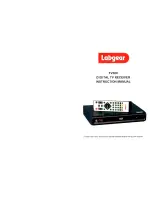
Introduction
The DigiTagLR Receiver is designed to be used with the DigiTagLR
range of active transmitters from the CDVI Group. Best performance
from the transmitter and receiver will be gained when adhering to all
the relevant instructions. The DigiTagLR receiver will read and decode
the secure coded signals from the transmitter when in the field range
of the receiver and validate this against the internal memory store of
up to 30 transmitters. A single timed relay output is available on this
model to signal electronic door locking or other automation equipment.
The DigiTagLR receiver is equipped with a low / high gain selector and
a range attenuator for further transmitter detection range reduction.
The exact range is dependant on environmental conditions, mounting
proximity to metal objects and battery condition of the transmitter. The
DigiTagLR receiver contains an internal antenna that must not be
modified as it is tuned for best performance in the factory. It must
always be mounted vertically and clear of metal obstacles or
mountings. Additionally an external antenna (SEA433) can be used if
you need to site the receiver elsewhere or inside metallised structures.
This is connected to the miniature screw terminals inside the receiver
housing.
Digitag-LR Types
Digitag-LR Receiver ..............................
DTRR1434R
Digitag-LR Transmitter w/button ............
DTXT1434
Digitag-LR Transmitter ..........................
DTXT0434
Technical Specification
Receiver
Operating frequency .............................433,92 MHz
Operating voltage .................................12-30 VDC
Operating current
in stand-by ............................................25 mA
with relay excited ..................................60 mA
Range15M nominal ..............................(conditions dependant)
Internal memory....................................30 transmitters, non volatile
Output interface ....................................Relay SPCO, form C
Relay contact power .............................24 VA - max 24 Vac :
ONLY
SELV Circuits
Control 1 ...............................................high / low gain
Control 2 ...............................................10 point attenuator
LED.......................................................1 green and 1 red
Antenna ................................................Internal helical / external connection 50 Ohm
Sensitivity..............................................-102dBm
Operating temperature..........................-10°C / +70°C
Transmitter
Operating frequency .............................433,92 MHz
Modulation ...........................................FSK
E.r.p ......................................................5 µW
Supply...................................................3V
Battery ..................................................CR2032
Installation Procedure
The DigiTagLR Receiver is designed to be mounted in proximity to the door or gate opening at a height of 1200 – 1400 mm. It is not
recommended that the receiver is mounted over the door, but as a conventional access control reader would be. Always mount the receiver
in the upright position. The DigiTagLR receiver has an internal antenna that detects the DigiTagLR range of active transmitters most
efficiently at the front and the rear of the unit. Avoid mounting the reader on or near large metal surfaces as this could cause poor reading
for
DIGITAG-LR - Stand alone version
DTRR1434R
DTXT1434
DTXT0434
Fixing the enclosure
1 - Mark the location of the fixing holes using the drilling
template supplied with the receiver ( Fig. 2 );
2 - Drill the fixing holes.( Fig. 3) (Hole diam: 5mm) ;
3 - Locate the plugs ( Fig. 4 );
4 - Assemble the seal and the receiver ( Fig. 5 );
5 - Mount the receiver with the screws supplied
( Fig. 6 );
6 - Make the electrical connections and the adjustments
required ( see next paragraph);
7 - After the adjustments, fit the cover using the the
screws supplied ( Fig. 7).
Fig. 2
Fig. 3
Fig. 4
Fig. 5
Fig. 6
Fig. 7
performance, erratic transmitter detection or non-linear
operation. The receiver can not read active transmitters
through metal objects and will be impeded by large dense
obstacles between it and the transmitter so always think




















